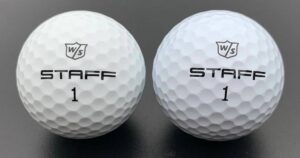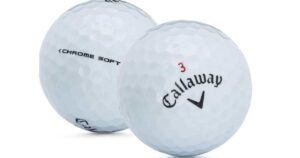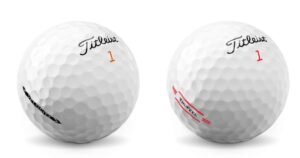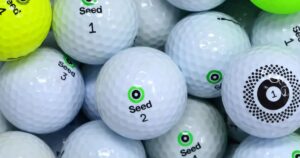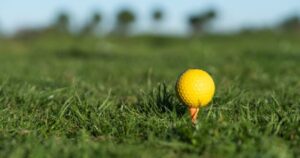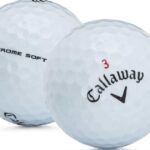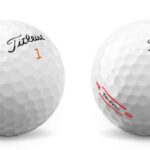Golf balls contain a carefully engineered interior structure that plays a pivotal role in their performance on the course.From the core that imparts initial velocity to the mantle that controls spin and the dimpled cover that influences aerodynamics, this article delves into the components that make up the heart of this essential piece of golfing equipment.
When you’re out on the golf course, you might not give much thought to the golf ball you’re using. But have you ever wondered what’s inside that little white sphere? explores the internal composition of a golf ball, unraveling the intricate structure that defines its performance on the golf course
In this article, we’re going to take a closer look at the anatomy of a golf ball, unraveling the mysteries within. From the core to the cover, we’ll explore the inner workings of these small but essential pieces of golfing equipment.
What’s Inside A Golf Ball?
At the core of every golf ball lies a solid core, typically composed of materials like rubber or composite, responsible for imparting the initial velocity and distance when struck. Surrounding the core, there’s a mantle layer, which controls spin and helps in optimizing the ball’s flight.
The outermost layer, the cover, is usually made of durable materials like urethane or Surlyn, and it features the signature dimples crucial for reducing aerodynamic drag and ensuring a stable trajectory.
All these components work in harmony to make each golf ball unique and tailored to various golfers’ needs, from distance-focused to those prioritizing control and feel. Understanding what’s inside a golf ball is a key factor in selecting the right ball to match your playing style and preferences on the golf course.
1-Piece Golf Balls
piece golf balls, also known as X Out Golf Balls, are the simplest and most economical option. These balls are primarily used for practice at driving ranges and are not suitable for actual rounds of golf.
They are constructed with a single, solid core, usually made of low-cost materials. As a result, they lack the performance characteristics needed for precision and distance. 1-piece golf balls are excellent for beginners and golfers looking to work on their swings without worrying about losing expensive balls.
2-Piece Golf Balls
2-piece golf balls are the most common and popular type among recreational golfers. They consist of a solid core, often made of high-energy materials like polybutadiene, encased in a durable cover.
The core provides excellent distance, while the cover offers durability. These balls are known for their affordability and are ideal for mid to high handicap players looking for a balance between distance and control.
3-Piece Golf Balls
3-piece golf balls take performance up a notch. They have a multi-layer construction that includes a core, mantle, and cover. The core is designed for distance, the mantle for spin control, and the cover for durability.
These balls are often used by low to mid-handicap players who want more control over their shots. With a softer feel and better spin, 3-piece golf balls provide an advantage in the short game.
4-Piece Golf Balls
4-piece golf balls are designed for golfers who demand top-tier performance. They feature an additional inner mantle layer between the core and outer mantle. This intricate construction provides exceptional control, distance, and spin. Advanced players, including professionals, often prefer 4-piece golf balls for their ability to shape shots and control trajectories with precision.
5-Piece Golf Balls
5-piece golf balls take golf ball engineering to the next level. They include five distinct layers, each serving a specific purpose. These balls offer the ultimate in performance, with exceptional distance, spin control, and feel. However, they are typically used by the most skilled golfers who can maximize the benefits of this advanced design.
6-Piece and Beyond
While 6-piece and higher-layer golf balls exist, they are exceptionally rare and are usually reserved for experimental or novelty purposes. These ultra-high layer golf balls are designed to push the boundaries of golf ball technology, offering unique characteristics that cater to very specific playing styles or conditions.
A Short History of the Inside of Golf Balls

The evolution of the inside of golf balls has been a fascinating journey. In the early days of golf, the “feathery” golf ball was the standard. These handcrafted balls had a core made of compacted feathers tightly bound by leather, providing limited distance and durability. In the mid-1800s, the “gutta-percha” ball emerged, featuring a rubber-like core.
This innovation significantly improved performance, offering better distance. As the years passed, golf ball design continued to evolve, eventually leading to the multi-layer balls we see today. These modern golf balls boast intricate constructions, with cores, mantles, and covers optimized for distance, spin, and control.
The ongoing quest for the perfect golf ball has resulted in a wide array of choices, each with its unique characteristics, allowing golfers to select the ball that best suits their playing style.
Construction of a Golf Ball
The construction of a golf ball is a fascinating blend of engineering and materials science. A typical golf ball comprises several key components, each playing a crucial role in its performance. At its core, there’s the solid or multi-layer core, which imparts initial velocity to the ball upon impact with the clubface.
Surrounding the core is the mantle, a layer designed for spin control. The outermost layer, the cover, is usually made of durable materials like urethane or Surlyn and features a dimpled surface that significantly affects aerodynamics and flight stability.
The combination of these elements, from the core to the cover, results in a golf ball with specific characteristics, allowing golfers to achieve the distance, control, and feel they desire. This intricate construction underscores the precision and innovation that golf ball manufacturers invest in perfecting the golfing experience.
The Core: The Heart of the Ball
At the heart of every golf ball is its core, which plays a crucial role in determining how the ball performs. The core is typically made of a solid rubber or composite material. It’s designed to provide the golf ball with its initial velocity and distance when struck by the clubface. The core can vary in size and composition, influencing the ball’s characteristics, such as its spin rate, compression, and feel.
Types of Cores
There are two primary types of cores found in golf balls:
Two-Piece Cores: These are the most common cores and consist of a single solid core, typically made of a high-energy material like polybutadiene. Two-piece cores are known for their distance and durability.
Multi-Layer Cores: Multi-layer cores, often found in premium golf balls, have multiple layers of different materials. They are designed to provide a balance of distance, spin, and control.
What Makes the Ball Feel Soft or Firm
The compression rating of a golf ball refers to how much the ball deforms when struck. Low-compression balls deform more, making them feel softer. High-compression balls are firmer and don’t deform as much. This characteristic influences the feel and control you experience when hitting the ball.
Choosing the Right Ball
Selecting the right golf ball depends on your skill level, swing speed, and personal preferences. If you have a slower swing speed, you may benefit from a low-compression ball, which can help you generate more distance. Advanced players may prefer higher-compression balls for better control and shot-shaping abilities.
FAQs
Why are dimples on a golf ball so important?
Dimples reduce aerodynamic drag, allowing the ball to maintain a stable flight and maximize distance.
What’s the significance of compression in golf balls?
Compression affects the feel and control of the ball when struck, with low-compression balls feeling softer and high-compression balls feeling firmer.
How do I choose the right golf ball for my game?
Consider your skill level, swing speed, and personal preferences when selecting a golf ball.
Are multi-layer golf balls better than two-piece balls?
It depends on your playing style and preferences. Multi-layer balls offer more customization, while two-piece balls are known for their distance.
What materials are commonly used for golf ball covers?
Urethane and Surlyn are common materials used for golf ball covers due to their durability and performance benefits.
Conclusion
The next time you tee up on the golf course, take a moment to appreciate the intricate design of the golf ball you’re using. From the core to the cover, each component serves a specific purpose, allowing you to make that perfect shot. Understanding what does the inside of a golf ball look like can help you make an informed choice when selecting the right ball for your game.

